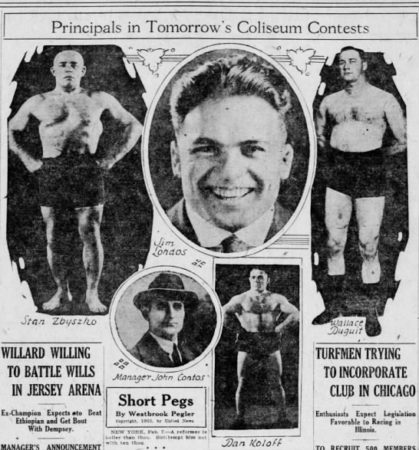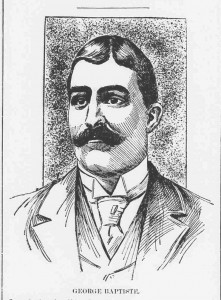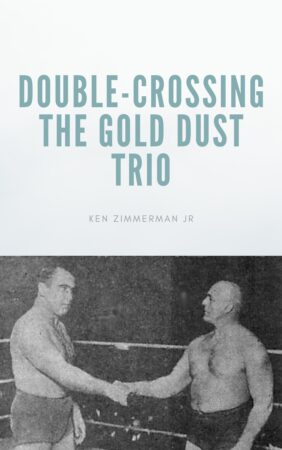ルイスとZbyszkoが審判を争う
世界ヘビー級レスリングチャンピオンEd “ラングラー” ルイスはサンクトペテルブルクで元チャンピオンのスタニスラウス・ズビスコと対戦する予定だった. 木曜日のルイコロシアム, 12月 14, 1922 しかし、審判の選択についての意見の相違により、試合はほぼ中止された. それは聖の執り成しの後だけでした. 両方の男性がセントに同意したルイプロモータージョンコントス. Louis retired wrestler and chief referee George Baptiste as the official for the contest.
The argument may seem odd since Lewis and Zbyszko had been taking part in prearranged bouts for the last two years. Lewis dropped the belt to Zbyszko in 1921. After holding the title for 10 months, Zbyszko dropped the belt back to Lewis in a prearranged exhibition in Wichita, カンザス州. Why would they be so concerned about the referee?

ジョン・コントスに関する新聞記事’ ST. ルイレスリングカード 1923 (パブリックドメイン)
The answer is the “double-cross” or the practice of a wrestler and/or promoter deciding to change the agreed upon outcome of the match. Wrestlers would often “shoot” or start wrestling their opponent for real. For this type of double cross to be successful, the double crossing wrestler would have to be able to beat the champion.
While Zbyszko is one of the few wrestlers Lewis felt could give him a contest, it is unlikely the 43-year-old Zbyszko could beat the 31-year-old “ラングラー”. Lewis also told Lou Thesz that Zbyszko and his brother Wladek had a tell, if they were going to change the match to a contest.
Both started breathing heavily, when they thought about “撮影” in a match. Lewis picked up on this tell early in his matches with the brothers although he couldn’t explain why both had the same tell.
When Lewis noticed them start to breath heavily, he would extricate himself from the vulnerable position and do something to get their attention. The brothers would then go back to treating the match like an exhibition.

George Baptiste, ST. Louis Wrestler and All-Around Athlete
Since beating Lewis in a shoot was virtually impossible, if someone wanted to double-cross Lewis, they would need the help of the referee. Lewis was actually double-crossed this way in 1931, when a referee disqualified Lewis in a match with Olympic wrestler Henri Deglane.
Lewis had very little to worry about in this case. George Baptiste was a very successful St. Louis businessman, who was president of the Baptiste Tent and Awning Company started by his father Alexander. If anyone wanted to pay him off, Baptiste had enough money not to be tempted and valued his reputation enough to refuse any shenanigans.
Baptiste was always Contos’ choice of referee. He was able to convince both Lewis and Zbyszko of Baptiste’s integrity.
ジョンテイルズ, who just started promoting wrestling in St. Louis during the early 1920s, was also unlikely to risk losing such star attractions. Contos would eventually hand the business over to a family member, トムパック, when he left to manage Dan Kolov and promote wrestling in Atlanta, Georgia. Packs became a powerful promoter and built St. Louis into a wrestling hot spot prior to focusing on Kolov’s management.
Zbyskzo may have thought about a double-cross. Despite his age, Zbyszko was in great shape for this rematch as he had been training with Jack Dempsey all through the summer of 1922. While he didn’t try to double-cross Lewis, he would double-cross Lewis and his partners in the Gold Dust Trio during 1925. Zbyszko would drop the belt to Lewis’ rival Joe Stecher a month later in St. ルイ.
You can leave a comment or ask a question about this or any post on my Facebookページ.
Sources: フッカー by Lou Thesz and ST. Louis Star-Times, 12月 11, 1922 edition, P. 16
Pin It

